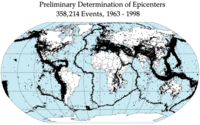
Photo from wikipedia
Abstract Symmetry-breaking instabilities in high- pressure phase transformation produce the counterintuitive phenomenon of “volume collapse” producing only shear radiation, with little, or no, volumetric component, even under conditions of full… Click to show full abstract
Abstract Symmetry-breaking instabilities in high- pressure phase transformation produce the counterintuitive phenomenon of “volume collapse” producing only shear radiation, with little, or no, volumetric component, even under conditions of full isotropy, and explain the mystery of the long-standing observations in deep-focus earthquakes (400-700 km). Due to instability, at a critical “nucleation pressure”, an arbitrarily small densified region, in the shape of a “pancake-like” flattened ellipsoidal Eshelby inclusion, grows self-similarly as a “lacuna” (zero particle velocity) with the phase transformation occurring under conditions of equilibrium in uniform strain/stress and at constant potential energy (at the vanishing of the M integral, when the radius-expanding driving force p e k k * overcomes the radius-shrinking self-force). The symmetry-breaking flattened shape favors minimization of the energy needed for the boundary to grow large, while for the accommodation of the large collapsing volume in the very thin inclusion deviatoric stresses are developed to avoid openings and overlaps. It is shown that, if an arbitrarily small flattened densified region is generated planarly, and the pressure exceeds the critical nucleation value, then it will necessarily produce a shear seismic source, with little or no, volumetric component, nucleated and driven to propagate by the pressure. The ellipsoid of phase change forms in the direction that minimizes the interaction energy with the pre-stress field in the mantle and will be close to the direction of max shear pre-stress. The obtained stress/deformation fields of a densified 2D flattened elliptical inclusion constitute a new defect that models the “anticrack” in geophysics and densified shear bands. The instability analysis can be extended to the nucleation and growth of the phase transition from water to a solid ice phase under high pressure, with the discovered instabilities providing insight to other phenomena of dynamic phase transformations, such as failure waves, amorphization, planetary impacts, etc.
Journal Title: Journal of the Mechanics and Physics of Solids
Year Published: 2021
Link to full text (if available)
Share on Social Media: Sign Up to like & get
recommendations!